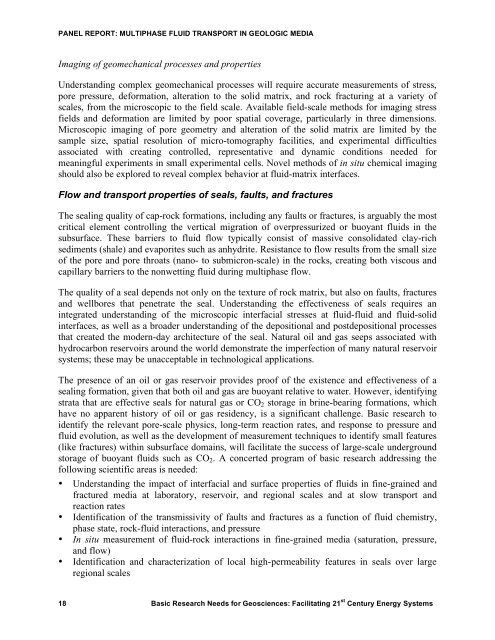Basic Research Needs for Geosciences - Energetics Meetings and ...
Basic Research Needs for Geosciences - Energetics Meetings and ...
Basic Research Needs for Geosciences - Energetics Meetings and ...
- No tags were found...
You also want an ePaper? Increase the reach of your titles
YUMPU automatically turns print PDFs into web optimized ePapers that Google loves.
PANEL REPORT: MULTIPHASE FLUID TRANSPORT IN GEOLOGIC MEDIAImaging of geomechanical processes <strong>and</strong> propertiesUnderst<strong>and</strong>ing complex geomechanical processes will require accurate measurements of stress,pore pressure, de<strong>for</strong>mation, alteration to the solid matrix, <strong>and</strong> rock fracturing at a variety ofscales, from the microscopic to the field scale. Available field-scale methods <strong>for</strong> imaging stressfields <strong>and</strong> de<strong>for</strong>mation are limited by poor spatial coverage, particularly in three dimensions.Microscopic imaging of pore geometry <strong>and</strong> alteration of the solid matrix are limited by thesample size, spatial resolution of micro-tomography facilities, <strong>and</strong> experimental difficultiesassociated with creating controlled, representative <strong>and</strong> dynamic conditions needed <strong>for</strong>meaningful experiments in small experimental cells. Novel methods of in situ chemical imagingshould also be explored to reveal complex behavior at fluid-matrix interfaces.Flow <strong>and</strong> transport properties of seals, faults, <strong>and</strong> fracturesThe sealing quality of cap-rock <strong>for</strong>mations, including any faults or fractures, is arguably the mostcritical element controlling the vertical migration of overpressurized or buoyant fluids in thesubsurface. These barriers to fluid flow typically consist of massive consolidated clay-richsediments (shale) <strong>and</strong> evaporites such as anhydrite. Resistance to flow results from the small sizeof the pore <strong>and</strong> pore throats (nano- to submicron-scale) in the rocks, creating both viscous <strong>and</strong>capillary barriers to the nonwetting fluid during multiphase flow.The quality of a seal depends not only on the texture of rock matrix, but also on faults, fractures<strong>and</strong> wellbores that penetrate the seal. Underst<strong>and</strong>ing the effectiveness of seals requires anintegrated underst<strong>and</strong>ing of the microscopic interfacial stresses at fluid-fluid <strong>and</strong> fluid-solidinterfaces, as well as a broader underst<strong>and</strong>ing of the depositional <strong>and</strong> postdepositional processesthat created the modern-day architecture of the seal. Natural oil <strong>and</strong> gas seeps associated withhydrocarbon reservoirs around the world demonstrate the imperfection of many natural reservoirsystems; these may be unacceptable in technological applications.The presence of an oil or gas reservoir provides proof of the existence <strong>and</strong> effectiveness of asealing <strong>for</strong>mation, given that both oil <strong>and</strong> gas are buoyant relative to water. However, identifyingstrata that are effective seals <strong>for</strong> natural gas or CO 2 storage in brine-bearing <strong>for</strong>mations, whichhave no apparent history of oil or gas residency, is a significant challenge. <strong>Basic</strong> research toidentify the relevant pore-scale physics, long-term reaction rates, <strong>and</strong> response to pressure <strong>and</strong>fluid evolution, as well as the development of measurement techniques to identify small features(like fractures) within subsurface domains, will facilitate the success of large-scale undergroundstorage of buoyant fluids such as CO 2 . A concerted program of basic research addressing thefollowing scientific areas is needed:• Underst<strong>and</strong>ing the impact of interfacial <strong>and</strong> surface properties of fluids in fine-grained <strong>and</strong>fractured media at laboratory, reservoir, <strong>and</strong> regional scales <strong>and</strong> at slow transport <strong>and</strong>reaction rates• Identification of the transmissivity of faults <strong>and</strong> fractures as a function of fluid chemistry,phase state, rock-fluid interactions, <strong>and</strong> pressure• In situ measurement of fluid-rock interactions in fine-grained media (saturation, pressure,<strong>and</strong> flow)• Identification <strong>and</strong> characterization of local high-permeability features in seals over largeregional scales18 <strong>Basic</strong> <strong>Research</strong> <strong>Needs</strong> <strong>for</strong> <strong>Geosciences</strong>: Facilitating 21 st Century Energy Systems
















